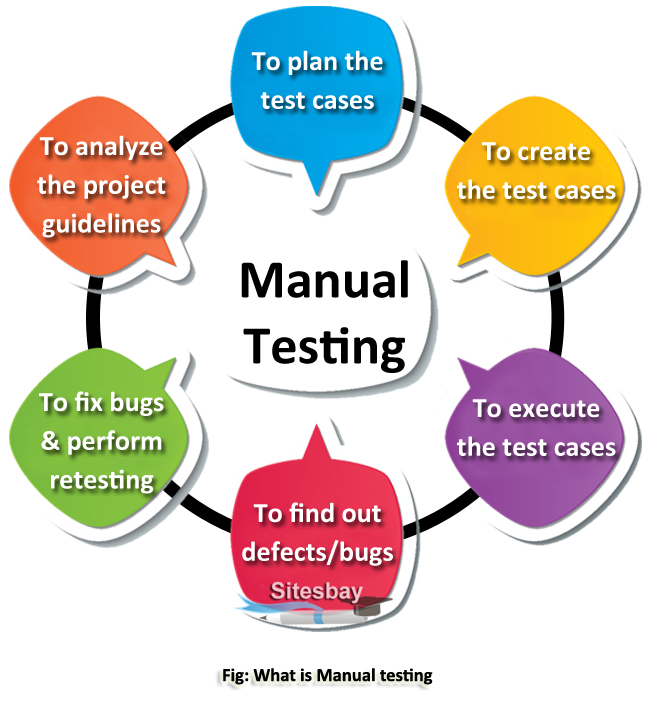Have you ever wondered how the apps on your phone or the websites you visit daily seem to work flawlessly? Behind the scenes, a team of skilled testers ensures quality and functionality through rigorous testing processes. Software testing is a crucial, yet often unseen, aspect of software development, involving both manual and automated approaches to guarantee a smooth user experience.

Image: becominghuman.ai
This comprehensive guide will delve into the intricate world of software testing, exploring both manual and automated approaches. We’ll discuss the benefits and drawbacks of each, showcase real-world examples, and provide valuable insights on how organizations can optimize their testing strategies for greater efficiency and effectiveness. Whether you’re a seasoned developer, a curious tech enthusiast, or simply want to understand how software gets shipped without major glitches, this guide will equip you with the knowledge to navigate the fascinating world of software testing.
Understanding Software Testing: A Foundation
Software testing, in essence, is the process of evaluating a software application to identify any bugs, defects, or areas for improvement. It’s a systematic approach to ensure that the software meets its intended functionality, usability, performance, and security requirements. Testers play a crucial role, acting as the final gatekeepers before software is released to the public.
The Importance of Software Testing
Software testing is not merely a formality but a crucial investment in delivering high-quality software. It delivers multiple benefits, including:
- Enhanced User Experience: By uncovering and eliminating bugs, testing ensures a seamless and enjoyable user experience. Users are less likely to encounter frustrating crashes or glitches, leading to higher satisfaction and engagement.
- Reduced Costs: Identifying and fixing issues early in the development cycle is significantly cheaper than addressing them during or after deployment. This proactive approach minimizes costly rework and saves time and resources.
- Increased Reliability and Stability: Thorough testing helps identify and fix security vulnerabilities, ensuring the software remains robust and protected from malicious attacks. This safeguards sensitive data and user privacy.
- Improved Performance: Testing under various load conditions helps identify performance bottlenecks and optimize the software’s efficiency. This leads to faster response times and a smooth user experience, even during peak usage.
- Reduced Risk of Failure: Testing helps mitigate the risks of deploying software with significant defects. By identifying and addressing potential issues early on, organizations can minimize the likelihood of costly software failures and negative reputational impacts.
Manual Testing: The Human Touch
Manual testing, as the name suggests, involves human testers interacting with the software, simulating real-world user scenarios to identify any anomalies or issues. This approach requires meticulous attention to detail, a keen understanding of user behavior, and the ability to think creatively to uncover unexpected flaws.

Image: www.sitesbay.com
Benefits of Manual Testing
- Discovering User Experience Issues: Manual testers can identify usability issues that automation might miss. They can assess the overall user experience and provide feedback on the intuitiveness of the interface, the flow of navigation, and the effectiveness of features.
- Flexibility and Adaptability: Manual testing allows for greater flexibility, as testers can adjust their approach based on real-time observations and adapt to changing requirements. This makes it ideal for exploratory testing and investigating complex scenarios.
- Uncovering Subtle Errors: Manual testing is particularly useful for identifying nuanced issues that automation might overlook. These could include minor visual glitches, inconsistencies in language, or issues related to user perception.
Types of Manual Testing
Manual testing encompasses various techniques, each tailored to different aspects of the software. Some common types include:
- Functional Testing: This verifies that the software functions as expected, performing critical tasks and calculations accurately. It ensures that all features operate as designed and meet pre-defined requirements.
- Usability Testing: This assesses the ease of use and intuitiveness of the software for target users. Testers evaluate the navigation, user interface, and overall user experience to ensure it’s intuitive and enjoyable.
- Exploratory Testing: In exploratory testing, testers explore the software without a predefined script, aiming to discover unexpected features and uncover hidden bugs. This approach encourages creative thinking and can lead to valuable insights.
- Acceptance Testing: This is performed by users or stakeholders to confirm that the software meets their expectations and requirements. It focuses on the end-user perspective and helps ensure the software is ready for deployment.
Automated Testing: Efficiency and Repeatability
Automated testing utilizes specialized software tools to execute test cases, compare results with expected outcomes, and generate reports. This approach offers significant benefits in terms of efficiency, speed, and repeatability, automating repetitive tasks and freeing up manual testers for more complex and creative work.
Benefits of Automated Testing
- Increased Efficiency and Speed: Automation significantly speeds up the testing process, allowing for a larger number of test cases to be executed quickly and efficiently. This reduces the overall time required for testing and accelerates the software development cycle.
- Improved Accuracy and Repeatability: Automated tests are executed consistently without human error, ensuring accurate and reliable results. This eliminates the potential for human biases and inconsistencies, leading to more reliable test results.
- Reduced Cost and Effort: By automating repetitive tasks, organizations can reduce the manual effort required for testing, freeing up human testers to focus on more strategic and creative aspects of quality assurance.
- Early Bug Detection: Automated tests can be integrated into the development pipeline, allowing for early detection of bugs and issues, thereby reducing the cost of fixing them later. This leads to faster bug resolution and improved software quality.
- Regression Testing: Automated testing is essential for regression testing, which ensures that new changes or features haven’t introduced unintended bugs or broken existing functionalities. It helps maintain software integrity over time.
Types of Automated Testing
Automated testing encompasses a wide range of techniques, each suited for different testing scenarios. Some common types include:
- Unit Testing: This focuses on testing individual units or components of the software in isolation. It ensures that each unit functions correctly and meets its specified requirements.
- Integration Testing: Integration testing verifies the interactions between different units or components of the software. It ensures that the components work together as intended and data flows correctly between them.
- System Testing: This tests the entire software system as a whole, verifying its functionality, performance, and compatibility with other systems. It ensures that the software meets its overall requirements and functions as expected in a real-world environment.
- Performance Testing: This assesses the software’s performance under various load conditions, such as high traffic or resource-intensive operations. It helps identify bottlenecks and optimize the software for efficient and reliable performance.
- Security Testing: This assesses the software’s vulnerability to security threats, such as hacking attempts, data breaches, or malicious code injection. It helps identify and fix security weaknesses to protect sensitive data and user privacy.
Choosing the Right Testing Approach
While both manual and automated testing play vital roles in ensuring software quality, the choice of approach depends on various factors, including the complexity of the software, the available resources, and the specific testing goals.
When to Choose Manual Testing
- Usability Evaluation: Manual testing is particularly valuable for evaluating the software’s usability, as it allows testers to understand the user experience and provide feedback based on human interaction and perception.
- Exploratory Testing: For exploratory testing, where the goal is to discover hidden bugs and assess the unexpected behavior of the software, manual testing offers greater flexibility and creativity.
- Limited Budget or Resources: If an organization has limited resources or budget for automation, manual testing can provide a cost-effective alternative, allowing for basic functionality testing and user experience evaluation.
When to Choose Automated Testing
- Repetitive Tasks: For repetitive tasks, such as regression testing or running a large suite of test cases, automation is highly beneficial, as it increases efficiency, speed, and accuracy.
- Performance and Load Testing: Performance and load testing, which require running a large number of tests under various stress conditions, are ideally suited for automation because of the speed and scalability it provides.
- Early Bug Detection: Integrating automated testing into the development pipeline allows for early detection of bugs, preventing them from cascading further into the codebase and reducing the cost of fixing them later.
The Future of Software Testing: Trends and Innovations
The field of software testing is continuously evolving, with new technologies and methodologies emerging to address the growing complexity of modern software applications. Some of the prominent trends shaping the future of software testing include:
- Artificial Intelligence (AI) and Machine Learning (ML) in Testing: AI and ML are increasingly used to automate testing processes, analyze data to identify patterns, and predict potential bugs. This includes intelligent test case generation, test automation, and defect prediction, making testing more efficient and effective.
- Cloud-Based Testing: Cloud-based testing platforms offer scalable and flexible infrastructure for executing tests, allowing organizations to access computing power and resources on demand. This simplifies test environment setup and deployment, speeding up the testing process.
- Shift-Left Testing: The shift-left approach emphasizes involving testing early in the development cycle. Developers are encouraged to incorporate testing practices right from the beginning, leading to faster bug detection and improved software quality.
- Big Data Testing: Big data applications require specialized testing methods to validate their performance, scalability, and ability to handle massive datasets. This includes testing for data accuracy, completeness, and real-time processing capabilities.
- Mobile Testing: With the increasing prevalence of mobile devices, mobile testing has become crucial. This involves testing software applications across various mobile platforms, screen sizes, and network conditions to ensure a seamless user experience.
Software Testing Manual And Automation: A Comprehensive Guide Kuis
Conclusion
In a world where software is pervasive and constantly evolving, the role of testing is paramount. By understanding the principles of both manual and automated testing, organizations can build robust testing strategies that ensure high-quality software, reduce development costs, and deliver exceptional user experiences. This guide has provided a comprehensive overview of the key concepts, techniques, and trends in software testing, equipping you with the knowledge to navigate this dynamic field and embrace the future of software quality assurance.






